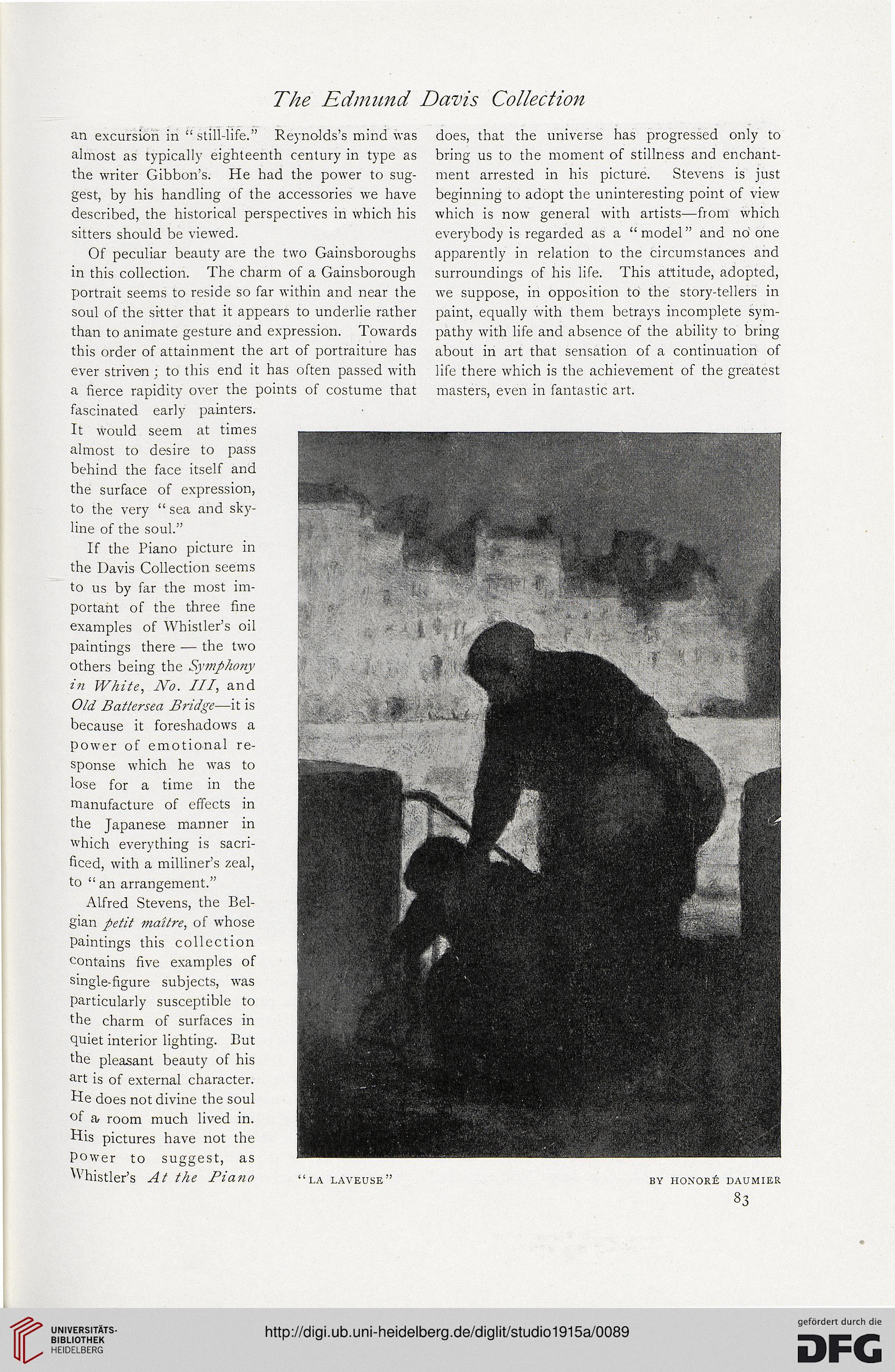The Edmund Davis Collection
an excursion in “ still-life.” Reynolds’s mind was
almost as typically eighteenth century in type as
the writer Gibbon’s. He had the power to sug-
gest, by his handling of the accessories we have
described, the historical perspectives in which his
sitters should be viewed.
Of peculiar beauty are the two Gainsboroughs
in this collection. The charm of a Gainsborough
portrait seems to reside so far within and near the
soul of the sitter that it appears to underlie rather
than to animate gesture and expression. Towards
this order of attainment the art of portraiture has
ever striven ; to this end it has often passed with
a fierce rapidity over the points of costume that
fascinated early painters.
It would seem at times
almost to desire to pass
behind the face itself and
the surface of expression,
to the very “ sea and sky-
line of the soul.”
If the Piano picture in
the Davis Collection seems
to us by far the most im-
portant of the three fine
examples of Whistler’s oil
paintings there — the two
others being the Symphony
in White, No. Ill, and
Old Battersea Bridge—it is
because it foreshadows a
power of emotional re-
sponse which he was to
lose for a time in the
manufacture of effects in
the Japanese manner in
which everything is sacri-
ficed, with a milliner’s zeal,
to “ an arrangement.”
Alfred Stevens, the Bel-
gian petit mailre, of whose
Paintings this collection
contains five examples of
single-figure subjects, was
Particularly susceptible to
the charm of surfaces in
quiet interior lighting. But
the pleasant beauty of his
art is of external character.
He does not divine the soul
°f a room much lived in.
His pictures have not the
power to suggest, as
Whistler’s At the Piano “la laveuse”
does, that the universe has progressed only to
bring us to the moment of stillness and enchant-
ment arrested in his picture. Stevens is just
beginning to adopt the uninteresting point of view
which is now general with artists—from w'hich
everybody is regarded as a “model” and no one
apparently in relation to the circumstances and
surroundings of his life. This attitude, adopted,
we suppose, in opposition to the story-tellers in
paint, equally with them betrays incomplete sym-
pathy with life and absence of the ability to bring
about in art that sensation of a continuation of
life there which is the achievement of the greatest
masters, even in fantastic art.
BY HONORS DAUMIER
83
an excursion in “ still-life.” Reynolds’s mind was
almost as typically eighteenth century in type as
the writer Gibbon’s. He had the power to sug-
gest, by his handling of the accessories we have
described, the historical perspectives in which his
sitters should be viewed.
Of peculiar beauty are the two Gainsboroughs
in this collection. The charm of a Gainsborough
portrait seems to reside so far within and near the
soul of the sitter that it appears to underlie rather
than to animate gesture and expression. Towards
this order of attainment the art of portraiture has
ever striven ; to this end it has often passed with
a fierce rapidity over the points of costume that
fascinated early painters.
It would seem at times
almost to desire to pass
behind the face itself and
the surface of expression,
to the very “ sea and sky-
line of the soul.”
If the Piano picture in
the Davis Collection seems
to us by far the most im-
portant of the three fine
examples of Whistler’s oil
paintings there — the two
others being the Symphony
in White, No. Ill, and
Old Battersea Bridge—it is
because it foreshadows a
power of emotional re-
sponse which he was to
lose for a time in the
manufacture of effects in
the Japanese manner in
which everything is sacri-
ficed, with a milliner’s zeal,
to “ an arrangement.”
Alfred Stevens, the Bel-
gian petit mailre, of whose
Paintings this collection
contains five examples of
single-figure subjects, was
Particularly susceptible to
the charm of surfaces in
quiet interior lighting. But
the pleasant beauty of his
art is of external character.
He does not divine the soul
°f a room much lived in.
His pictures have not the
power to suggest, as
Whistler’s At the Piano “la laveuse”
does, that the universe has progressed only to
bring us to the moment of stillness and enchant-
ment arrested in his picture. Stevens is just
beginning to adopt the uninteresting point of view
which is now general with artists—from w'hich
everybody is regarded as a “model” and no one
apparently in relation to the circumstances and
surroundings of his life. This attitude, adopted,
we suppose, in opposition to the story-tellers in
paint, equally with them betrays incomplete sym-
pathy with life and absence of the ability to bring
about in art that sensation of a continuation of
life there which is the achievement of the greatest
masters, even in fantastic art.
BY HONORS DAUMIER
83




